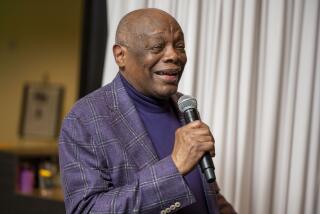An Indian Love Story Gone Awry, Willie Boy’s Legend Lives On
- Share via
A reputed 1909 double murder and suicide in Southern California led to the “last great manhunt” of the Old West, spawning national headlines; trumping up rumors of a presidential assassination plot and of an Indian uprising; and leaving a notorious legacy in books, a movie and finally a bitter academic fight that landed three authors in court.
The saga of Willie Boy, a 28-year-old Paiute-Chemehuevi Indian who apparently shot and killed the father of a 16-year-old girl he loved and then led lawmen on a deadly desert pursuit, was a love story gone awry.
But because the newspapers saw this as a way to boost circulation, Willie Boy went down in history as a drunken Indian murderer and potential presidential assassin, crazed with lust for a teenage girl he kidnapped and brutally murdered.
In 1900, 19-year-old Willie Boy was living in Victorville with his sister and her family. When two little boys, ages 6 and 8, were orphaned, Willie Boy took care of them, moving them from a nearby reservation. He was a quiet, hard-working cowpuncher with a good, sober reputation.
Despite his future national notoriety, he never left the Mojave Desert, working at ranches along California 62 in the Morongo and Yucca valleys and Joshua Tree before moving to Twentynine Palms.
There, in 1909, he fell in love with his 16-year-old distant cousin, Carlota Boniface. He had already been married, but that marriage had failed within the previous year.
Carlota’s father, William, nicknamed “Old Mike,” was no ordinary man to reckon with. He was a shaman of Willie Boy’s tribe, a powerfully built man with spiritual authority who refused to let his daughter marry a relative, no matter how distant.
Tribal customs also forbade such a marriage, declaring that it would only bring shame and dishonor to their families. Besides that, Old Mike just didn’t like Willie Boy.
Despite her father’s objections, Carlota ran off with Willie Boy, and the two spent the night together before relatives brought them back.
A few months later, when Carlota moved with her family to pick fruit on the Gilman ranch in Banning, 80 miles east of Los Angeles, Willie Boy followed.
On Sept. 26, desperately in love with Carlota, Willie Boy confronted Old Mike with a gun. Whether he shot the older man or the shaman died in a struggle over the weapon is not known.
But even as her husband lay dead, Carlota’s mother was sympathetic to the lovers. She gave them several hours’ head start before calling tribal police. Five men set off in pursuit.
The lovers began their trek, backtracking and circling to elude the posse. Eventually they crossed nearly 600 miles of sun-baked earth, averaging 50 miles a day in the inhospitable 100-degree heat, staying ahead of the lawmen for a dozen days.
Willie Boy was renowned in his tribe for long-distance running, and he knew all the watering holes. And members of his family were suspected of supplying the couple with food.
But early in October, it seemed that the food was running out. Willie Boy left Carlota and his few possessions behind near Landers in San Bernardino County, in an area called the Pipes, to replenish their provisions.
On Oct. 7, not long after Willie Boy left, one of the trackers far ahead of the posse mistook Carlota for Willie Boy and shot and killed her. He kept mum about his mistake, letting the other tracker find her body. Everyone, including the press, assumed Willie Boy had killed her. Not until a 1994 book detailed Carlota’s autopsy, proving the bullet had been fired from a long distance away, did that story die.
A “Wanted” poster with a $50 reward was soon issued, warning of a desperate man and a double murder.
Willie Boy returned just hours after Carlota had been shot and spotted the posse in the Pipes. Unaware that Carlota was dead, he tried to protect her by leading the posse away, north into Ruby Mountain.
There, he pinned them down in an ambush from a rock pile. Firing away, Willie Boy killed three horses and wounded another. Two bullets lodged in one deputy’s hip and thigh.
In an exchange of shouting between gunfire, the lawmen accused Willie Boy of brutally murdering Carlota because she had slowed his flight.
Then there was nothing but silence.
When the moon rose, the five posse members hoisted the wounded deputy into the saddle of the surviving horse and started back to Banning for a doctor. But before they got very far, they heard one last shot in the night.
Distraught over Carlota’s death and wanting to join her in the afterlife, Willie Boy had taken off his shoe, put the rifle barrel against his chest and squeezed the trigger with his toe. The weary lawmen, hearing the shot, suspected he had killed himself but didn’t go back to find out.
The press refused to believe Willie Boy was dead or to let a good story die. Hoping to raise circulation with white fears of a reckless Indian still on the loose, reporters trumped up rumors of a presidential assassination plot.
The timing was perfect. President William Howard Taft was scheduled to arrive in San Bernardino and Riverside counties as part of a national trip to buoy his presidential image.
Taft’s visit--along with the fact that his nickname was Billie Boy, an eerie echo of the young Indian’s--spurred men to form a larger posse to find either Willie Boy or his body.
Fear of an Indian revolt was stirred even further by Clara True, the agent in charge at the Morongo Indian Reservation. She told anyone who would listen that if Willie Boy was not captured quickly, other Indians might join him in rebellion.
Local farmers, anticipating an Indian attack, busied themselves cleaning guns. Children hesitantly walked to school, looking over their shoulders.
On Oct. 15, eight days after Willie Boy’s death and three days after Taft’s train rolled out of Riverside without incident, the posse found Willie Boy’s badly decomposed body at the ambush site on Ruby Mountain. They burned his body on the rocks where it lay.
Almost a half-century later, Willie Boy’s celebrated story was revived by author Harry Lawton in his book, “Willie Boy: A Desert Manhunt,” for which he interviewed surviving members of the posse. It got its widest audience in the 1969 movie “Tell Them Willie Boy Is Here,” starring Robert Redford.
But it wasn’t until 1994, when authors James A. Sandos and Larry E. Burgess wrote their take on events in “The Hunt for Willie Boy” that Willie Boy became the nexus of a bitter legal and academic fight that landed the story’s chroniclers in court.
In their book, Sandos and Burgess accused Lawton of being careless with the facts, calling him an “Indian-hater.” Lawton sued for libel; the case was settled without money changing hands. Sandos and Burgess were ordered to write a correction in any undistributed copies and future editions retracting the Indian-hater charge and other points of contention.
Later this year, Willie Boy’s story will take yet another twist when former deputy prosecutor, criminal defense attorney and Los Angeles County Municipal Judge James “Pat” Patterson’s novel “The Last Posse” is published. It is written from the perspective of a newspaper reporter.
On the reservation, Willie Boy’s reputation was not badly tarnished; his tale would continue to grow as part of the Chemehuevi storytelling tradition.
Others have taken up Willie Boy’s legend by putting landmarks at the end and beginning of his trail. Gilman Ranch Historic Park and Wagon Museum in Banning, en route to Palm Springs, stands where Old Mike was shot and killed. The remote town of Landers--northwest of Twentynine Palms and more famous for its 1992 earthquake these days--holds an annual “Willie Boy Days and Festival.” Nearby, at Ruby Mountain, a plaque commemorates the search that ended at Willie Boy’s suicide and cremation site. It reads: “Willie Boy, 1881-1909, The West’s Last Famous Manhunt.”
More to Read
Sign up for Essential California
The most important California stories and recommendations in your inbox every morning.
You may occasionally receive promotional content from the Los Angeles Times.













